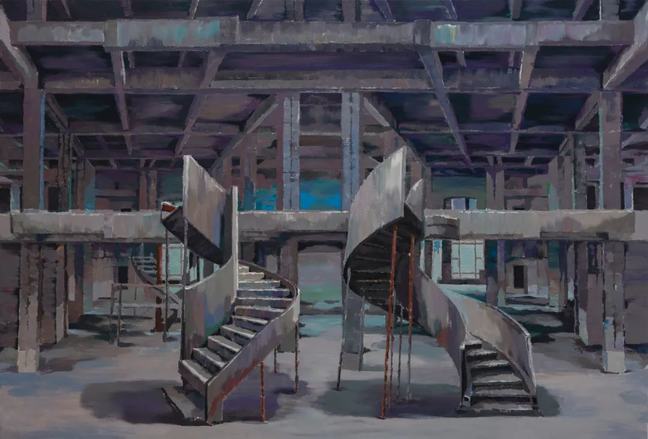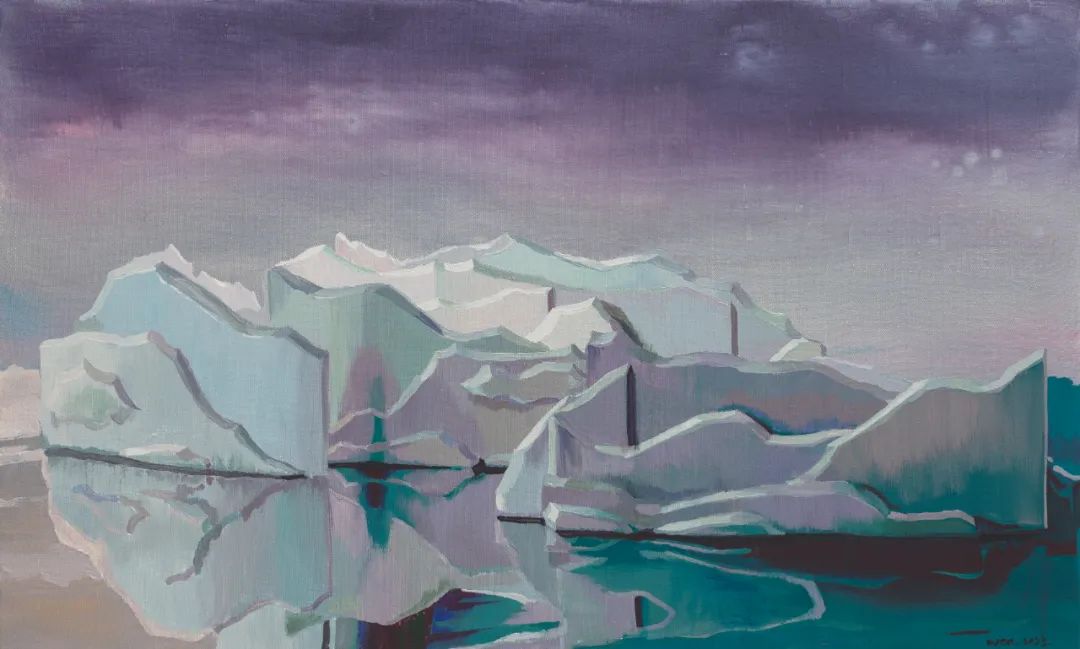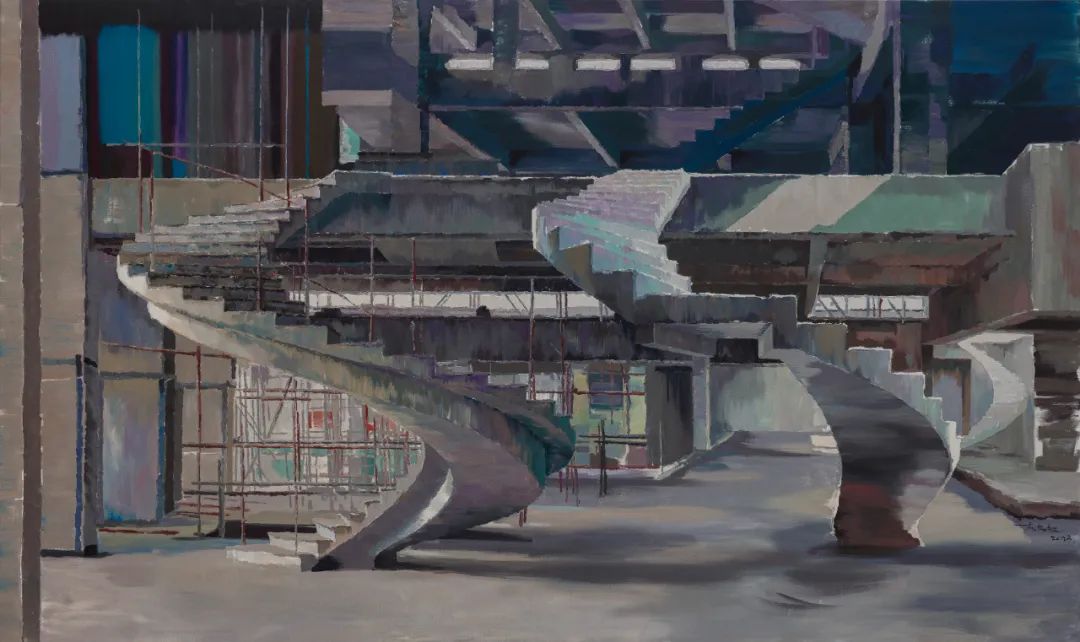
李易纹(左)与王澈(右)
Li Yiwen (L) and Wang Che (R)
李易纹的作品给人的感觉总是一种未来的过去式,这些画面来自于哪个时间面?应该把它放在哪个时间面?有一种不可定位的整体关系。
虽然没有一个人的情感不是藏身于过去的,但对于从过去提取并建立一个时间连续体或者多种时间系的横向沟通形式,算是李易纹在艺术上创造出来的一种转换方式,这种形式下的画面常常有一种空旷的“废墟”感,如果过去是一个废墟空间,那么未来也将是一堆废墟。废墟作为一种时间性,在我们的心理上很容易被感受到,这是否说明时间呈绵延循环的螺旋状,我们对时间的理解只是在此刻的精神提纯和绝对化的动作呢?李易纹出生的洛阳市是一个极其丰富并且扎实的历史空间,他儿时在龙门石窟中的成长经历是不是埋下了一种历史废墟的心理时间和空间感呢?在他之后的绘画创作中,人物几乎都是不在场的,色调也极其冷峻,但画面却总有一种被凝视的力度,放置在了画面之外一定的空间距离上。

同频 Identical Frequency
190x280cm,布面丙烯 Acrylic on canvas,2023
就像我和易纹共同去过的不同地域,发现了不同的时间存在一样,这些地域的空间、距离决定着时间的尺度,地域的差异建立了整体的时间心理,被切割的时间认识方式一下子就显得无效了。在2019年一起去新疆行走的时候,当我站在沙漠中的一个故城里,面对只有残破土墙的巨大空间,心理上的未来感却很强,我很难分辨这是一个历史空间还是一个未来空间,脑子里全是李易纹的作品,仿佛置身他的绘画中。还有一次在鄂尔多斯的康巴什新区的烂尾楼中,这些烂尾空间连绵好几公里,我翻越进去穿行其中,同样是一种模糊的时间和空间感,它极像一种从没有人生活过的空间,也极像一种人从这里消失了很久的空间,这种来自于身体感受的对于时间的理解,再一次让我感觉自己置身于李易纹的作品中。或许,时间并不是一个命题或一种概念,抛开思想层面,身体对于时间的感受,也是我对于李易纹作品中关于时间的一种理解方式。
我与易纹认识十来年,对于易纹的理解也是一个漫长的过程,我们常常聚在一起聊天、讨论、胡扯,但时间一长就没什么好谈的了,现在经常坐在一起喝酒发呆,偶尔冒出来一个话题,轻聊一下。易纹可以说是一个爱看书和听书的人,据我的观察他对于历史、物理、科学都存在着广泛的热情,常常在聊天的过程中不经意就会从历史谈到量子等话题,但现有物理理论对于生命的解释常常不能让人十分满意,再加上对于生活的感受越来越长,或是与我这么偏向直觉的朋友接触越来越久,易纹近些年的思考增加了很多直觉性的意味。比如他在阅读过程中对一些术语的“误读”,拓延了这些概念的原本意指,在转换成绘画后形成了一种比较个体而特别的审美。这种极其个体化的表达在我看来是一种对于知识概念性理解的警惕,并且在这一方式的研究和创作下形成的视觉,也能够给我们一种感受性的启示。

刹那-1 The Moment-1
90x150cm,布面丙烯 Acrylic on canvas,2023
如果说以前聚在一起是凭借各自的智力来解读这个物质世界运行的秘密的话,现在聚在一起便是出于本能,没有任何倾向性。本能便是通感①,虽然我们需要通过训练我们的智力来了解和改变这个世界,但仍然需要从本能出发对于外界最直观、最基本的感觉上来谈论这个世界。就像我经常在城市的空间中(画室、画廊)面对李易纹的作品时,很难理解的更深刻一样,误以为解读李易纹的作品需要极为深厚的哲学、物理学、数学、天文学等知识,但几次行走,在不同空间中的感受让我发现了一种理解他的渠道。城市空间和时间上的临时感、碎片化,将时间和空间切割的很碎,对于绵延的认识只能停留在概念上,我以为我认识了时间,但凝视河流真正在身边滔滔流过后,感受风把戈壁石吹成沙漠后,时间绝对就不仅仅是在钟表中那样被划分好的了。我认为李易纹的绘画也是如此,从这些年我们的行为变化到他的作品变化,智力与本能越来越被主动地统一在一起,并尝试建构新的意识。这种意识是个人精神连续性的状态,作为艺术家在文化的思考和实践层面,切断式的表达,碎片化的呈现是极度无效的行为。李易纹近几年的几个展览一直试图在关联性上强调时间的绵延起伏过程,也正是他的文化意识和艺术建构的自觉性吧。
这次展览的新作品中出现很多螺旋的图示,向上的动力和回归的急迫通过一个“黑洞”或者“白洞”作为界线,盘旋了起来,这些新作品的形式像是往十年前探了一下头。十年前我认识李易纹,十年后第一次作为他个展的策展人,似乎像是从认识易纹到再次认识易纹的螺旋过程,但谈论这个过程,与其说是哲学,不如说是诗,这十年,生命对现实体验的过程是十分复杂的有机性,它不像河流在自然推动下永恒的向下流动,生命往往是一种逆熵流,像是李易纹绘画中向上盘旋的艰难力度,这必定是对于生命过程有了不少洞见,想要超越个体生命之流向上永无止息的姿态。这个姿态背后却又隐藏着类似“湍流”②这样的过程,回应着由于不断被迫搬迁带来的生活和个人状态上的杂乱和波动,像一次次时间断面的投射。
如果盘旋的楼梯被看作是一串生命基因,那就像是生命在这“过去”的“未来”的空间背景下的共舞或纠缠,在一部时间交响乐中,每一段旋律在演奏的当下能被欣赏,又常常会被重复或是用来引出下一段旋律,这样才能形成连续的乐章。

双旋 Duplex DNA
190x320cm,布面丙烯 Acrylic on canvas,2023
Li Yiwen's artwork often evokes a sense of the future in the past. From which temporal dimension do these images arise? Where do they belong in time? There is an unplaceable relationship that encompasses the whole.
Although every person's emotions are rooted in the past, Li Yiwen has created a unique approach in his art by extracting and establishing a temporal continuity or multiple temporal systems for lateral communication from the past. In his works, there is often a feeling of desolation, as if depicting ruins. If history is a space of ruins, does this suggest that the future is also destined for ruins? The temporal quality of ruins is easily felt in our psychology, implying that time may be a spiral of continuity or merely a purification and absolutization of time at present. Li Yiwen was born in Luoyang, a city with a rich and solid historical background. Did his childhood experiences of growing up in the Longmen Grottoes plant a psychological sense of time and space, imbued with historical ruins? In his later paintings, human figures are almost non-existent, and the tones are exceedingly cold and austere. Nevertheless, there is always a penetrating gaze in the images, which is placed at a certain spatial distance outside the image.

黑洞 Collapsar
120x720cm,布面丙烯 Acrylic on canvas,2014
As Li Yiwen and I travelled to different geographical regions, we discovered different temporal existences that were shaped by the spatial distance and scale. The differences in geography established a collective temporal psychology that made our fragmented perception of time ineffective. In 2019, during our walk in Xinjiang, I stood in an ancient city in the desert, facing a vast space with only crumbling earthen walls. I felt a strong sense of the future, and it was hard to distinguish whether it was a historical or a futuristic space. Li Yiwen's works filled my mind, and I felt as if I was in one of his paintings. On another occasion, I walked through a few kilometres of abandoned buildings in Kangbashi New District in Ordos, and it was a vague sense of time and space, resembling a space where no one had ever lived, or a space where people had disappeared a long time ago. Once again, this interpretation of time derived from bodily sensations makes me feel as though I am transported into the realm of Li Yiwen's artwork. Perhaps time is not a proposition or a concept. Beyond the realm of thought, the bodily perception of time is also a way for me to understand Li Yiwen's works on time.
I've known Yiwen for about a decade and understanding him has been quite a journey. We used to gather and chat, discuss, and banter endlessly. But over time, our conversations have dwindled, and now we often find ourselves sitting together, quietly sipping drinks and lost in our own thoughts. Occasionally, a topic emerges, and we engage in light conversation. Yiwen is a true bookworm and audiobook enthusiast. From what I've observed, he has a profound passion for history, physics, and science in general. Our chats effortlessly meander from historical anecdotes to quantum physics and beyond. However, existing scientific theories often fail to satisfy our curiosity about life. As Yiwen becomes increasingly attuned to life's experiences and spends more time with intuitive friends like me, his thoughts have taken on a more instinctive nature in recent years. For instance, he "misinterprets" certain terms while reading, expanding their original meanings. When translated into his artwork, they give rise to a highly individualized aesthetic. To me, this intensely personal expression represents a vigilant approach to conceptual understanding, while the resulting visuals provide a sensory revelation.

刹那-2 The Moment-2
90x150cm,布面丙烯 Acrylic on canvas,2023
In the past, when we gathered together, it was driven by our individual intellects to decipher the secrets behind the workings of the material world. But now, our coming together is instinctual, devoid of any predisposition. Instinct is akin to synesthesia①. While we still need to train our intellects to comprehend and transform this world, we must also approach our understanding of the external world from an instinctual standpoint, focusing on its most immediate and fundamental sensations. Just as I often find myself in the urban spaces of studios and galleries, facing Li Yiwen's artwork, it becomes challenging to grasp their profound essence. One might mistakenly believe that interpreting Li Yiwen's creations demands a profound knowledge of philosophy, physics, mathematics, astronomy, and more. However, after several traverses through different spaces, I discovered a pathway to comprehend his work. The transient and fragmented nature of urban space and time slices them into shards, leaving our comprehension confined to the realm of concepts. We may assume to understand time, yet it is only when we gaze upon a flowing river or feel the wind moulding desert stones into sand that we realize time is no longer merely a neatly divided concept found on a clock face. Similarly, I believe that Li Yiwen's paintings operate in the same way. As the years have unfolded, witnessing changes in our behaviour alongside transformations in his artwork, intelligence and instinct have gradually merged, actively attempting to construct a fresh awareness. This form of consciousness embodies a state of personal spiritual continuity. As an artist, both in terms of cultural introspection and practical implementation, fragmented expression and disjointed presentation prove to be exceedingly futile endeavours. Li Yiwen's recent exhibitions consistently strive to emphasize the ebb and flow of time, intricately intertwining relevance. This emphasis serves as a testament to his cultural awareness and intentional artistic construction.
Within the new works showcased in this exhibition, there is an abundance of spiral imagery. The upward propulsion and compelling sense of return are encapsulated by a demarcation, be it a "black hole" or a "white hole," causing them to swirl and coil. The forms of these recent works seem to peek back into the past decade. A decade ago, I first encountered Li Yiwen, and now, after ten years, I find myself curating his solo exhibition for the very first time. It feels like a spiral journey, rediscovering Li Yiwen once more. Yet, when contemplating this process, it is more akin to poetry than philosophy. These past ten years have witnessed the intricate and organic interplay between life and the experiences it encounters in reality. Unlike a river's timeless downstream flow propelled by nature, life often manifests as a counter-entropic current. It mirrors the arduous striving depicted in Li Yiwen's paintings, spiralling upwards. Such endeavours undoubtedly reveal profound insights into the journey of life, seeking to transcend the mere individual existence and embody an unwavering ascent. However, beneath this resolute posture, lies a parallel process, akin to Turbulence②, it serves as a response to the disorder and fluctuations stemming from the relentless upheavals and personal transformations caused by forced relocations — a cascade of temporal cross-sections projected onto the canvas of existence.

共舞 Dance Together
190x320cm,布面丙烯 Acrylic on canvas,2023
If we consider the spiralling staircase as a sequence of life's genes, it resembles a collective dance or entanglement of life within the spatial backdrop of the past and future. In the symphony of time, each segment of melody can be cherished in its present performance, while frequently being reiterated or utilized to pave the way for the next melodic phase. It is through this interplay that a seamless composition of continuous movements unfolds, forming a harmonious orchestration.
Text by Wang Che

余晖 Evening Glow
50x50cm,布面丙烯 Acrylic on canvas,2022
1 《创造进化论》,亨利-伯格森,150页,2015年7月版,北京通州皇家印刷厂
Creative Evolution, Henri Bergson, pp. 150, July 2015, Beijing Tongzhou Royal Print.
2 李易纹个展名称,墨方空间,2021年
Turbulence, Li Yiwen’s solo exhibition held by Mocube, 2021
©文章版权归属原创作者,如有侵权请后台联系删除